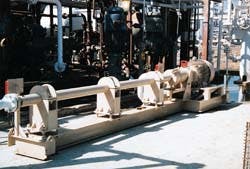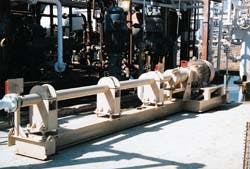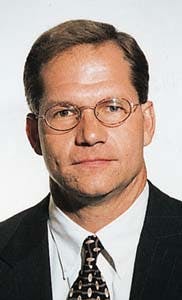Horizontal pumping system installed at East Texas gas plant
Michael Lopez
Union Pacific Resources Group Inc.
Carthage, Tex.
Bruce Goodwin
REDA
Marshall, Tex.
This typical installation of an HPS at UPR's East Texas gas plant shows the back-up can pumps in the background.Installation of horizontal, multistage centrifugal pumps in lean-amine service has proven successful and economical at Union Pacific Resources (UPR) East Texas gas plant (ETGP), Carthage, Tex.
In the past, UPR had used either vertical can pumps or positive displacement (PD) pumps for amine circulation in gas-treating operations. When the need to replace a PD pump in the No. 4 amine plant arose, UPR solicited bids from both traditional pump suppliers.
Additionally, UPR solicited a bid from REDA for its horizontal pumping system (HPS) based on previous success of this type of pump at ETGP for saltwater disposal.
Pump-system cost comparisons revealed that REDA's HPS had a capital cost savings of approximately 35% over PD or vertical can pump options. In addition, installation cost of the REDA pump showed a significant savings vs. a vertical can pump.
Thus, UPR opted to install and evaluate the performance of the HPS in amine service. This was the first installation of a horizontal multistage pump for amine service in UPR's gas treating plants and was also REDA's first use of its HPS in this type of application.
The first pump was installed in May 1996 and designed to circulate a maximum of 80 gpm. Since installation of the pump in No. 4 amine-treating unit, UPR has experienced no downtime and realized a significant cost savings on maintenance labor and parts over the previous positive displacement installation.
The success of this HPS in amine service has led UPR to invest in five additional HPS pumps for ETGP's amine service.
Repair or replace?
The UPR East Texas complex treats approximately 40,000 b/d of NGL which contains 4.5 wt % (mole) CO 2(Table 1 [34,672 bytes]) and is pipelined downstream to a fractionator in Mt. Belvieu, Tex.The pipeline specifications that govern delivery of this product require less than 1,000 ppm (wt) CO2 in the product stream. In order to meet these specifications, UPR incorporates the use of five parallel amine plants to remove the CO2 from the liquid product stream before delivery.
Four of these plants use liquid-to-liquid contactors, while the fifth plant uses a gas-to-liquid contactor. The amine solution used in all five of the plants is a 40 wt % aqueous solution consisting of a mixture of 70% diethanolamine (DEA) and 30% MDEA.
Table 1 also shows a typical treated-product stream before pipelining. Amine circulation rates in these plants range from 80 to 120 gpm.
In spring 1996, UPR was faced with repairing or replacing outdated PD pumps which were used to circulate amine in the No. 4 amine-treating unit at 820 psig operating pressure. Fig. 1 [58,408 bytes] is a typical flow diagram for one of the five amine-treating towers at ETGP.
Over the years, these pumps required high maintenance and frequently failed for various reasons including seal failures and broken pump shafts. After an evaluation of replacement costs and because of high maintenance costs UPR had experienced with the PD pumps in the amine system, they were quickly ruled out for replacement.
The other four plants incorporated the use of vertical can pumps for amine circulation, and thus it became an obvious choice for use at No. 4 amine-treating unit. Following initial bids to replace the PD pumps with vertical can pumps, economics were not deemed favorable and other alternatives were sought.
UPR's ETGP maintenance department suggested using an HPS, which is a horizontal multistage centrifugal pump.
Use of an HPS system was not new at the ETGP: In 1991, when UPR had to replace a pump on the water-disposal system, REDA had proposed use of its HPS. Economics justified installation of this pump, and the traditionally high maintenance cost of the disposal system dropped significantly.
The HPS used on the water-disposal system moves 3,600 b/d boosting from essentially atmospheric pressure and discharging at 1,100 psig. This pressure requirement was similar to that used in the No. 4 amine-treating unit, thus prompting the idea for the use of the HPS system by the ETGP maintenance department.
Economics
In 1995, UPR spent $65,000 on various repairs of the PD pumps used to circulate amine in its No. 4 amine-treating unit. Much of these costs were associated with packing leaks and rod and bearing failures. Various types of packing were tried with little success.These multiple failures would occasionally decrease the availability of the combined ETGP amine units. With them already at capacity, warming the cryogenic plants to compensate for the lack of treating capacity was required.
The ETGP purchasing coordinator was asked to solicit several vertical can pump manufacturers so that UPR could purchase and replace the PD pumps then being used.
This pump design included the following parameters: suction pressure, 25 psig; discharge pressure, 1,100 psig; circulation rate, 80 gpm; ceramic coated bowls; and stainless-steel impellers.
The four categories used to evaluate the pumps included purchase price, installation cost, estimated operating expense (based on past experience), and utility savings, if any.
The can pumps quoted exceeded a purchase price of $40,000. The cost of the HPS for No. 4 amine-treating unit was $21,000. That pump quote caused UPR further to evaluate using this pump in the amine system.
The installation cost of the vertical can pump vs. that of the HPS was then evaluated. The vertical can pump required that a 10-in. hole be drilled and lined with concrete for installation of the pump vs. placing the HPS on a pedestal, which required additional plant space but made it more accessible for maintenance. Cost savings over the installation were estimated at approximately $3,800.
An anticipated reduction of operating expenses was a major factor in using the HPS over the traditional vertical can pump.
Typically, the biggest problem associated with the vertical can pump was failure of the high-pressure seal. Each amine-treating unit experienced at least two failures per year.
During a failure, an idle backup pump was put into service to eliminate downtime on the amine plant. The cost to repair each pump after a failure ranged from $12,000 to $18,000. Much of this cost was associated with inspecting the pump when it was actually pulled from the can.
Because a crane was required to retrieve the pump from the can and based on past reliability, a pump when pulled was sent to the manufacturer for inspection and repairs to ensure longer run time between failures.
Also, to retrieve a vertical can pump, the motor had to first be removed and thus would require the use of electrical and instrumentation personnel which further added to the cost of repairs.
By contrast, the HPS appeared to be easily accessible, required no removal of the motor, and could easily be removed by one person aided by a small lift. Maintenance on this pump required changing thrust chamber oil quarterly. Also, a complete replacement for the pump cartridge was estimated at only $8,000.
The electrical cost of the initial HPS installation was compared to the existing PD pumps. The PD pumps were less efficient than the system proposed to UPR by REDA: UPR was using two 50-hp motors to drive two PD pumps required to circulate 80 gpm. The HPS design calculated out to 68 hp and a 75-hp motor was installed. Estimated electrical cost savings over that of the PD pumps for this application was $9,000/year.
REDA had no previous experience in using its pumps in this type of application but, because of its research, felt confident that it would hold up to the corrosive environment of an amine system, especially because it would be on the lean-service side of the treating plant.
UPR's biggest concern was with the metallurgy of the proposed pump. Past experience with vertical can pumps indicated that the entire pump had to be made of stainless steel or a ceramic-coated cast iron to compensate for the corrosive environment.
The REDA pump utilizes Ni-Resist type 1 metallurgy for the stage casting. Although still cast iron, this metallurgy is high in nickel content which provides for cost-effective corrosion resistance over the use of all 316-stainless steel.
Pumping systems
The original application was designed to pump lean amine (60% fresh water, 40% amine) with a 1.08 sp gr. A booster pump would provide a 25-psig inlet pressure. A desired pumping capacity of 80 gpm (2,744 b/d) at an 1,100 psig discharge pressure was specified.The actual design that was placed into operation (48-stage SN2600 pump) developed 1,070 psig discharge pressure at the 80-gpm rate requirement. Horsepower requirements for this design were calculated at 68 hp. A 75 hp totally enclosed fan cooled (TEFC), standard efficient motor was specified on the order. Fig. 2 [99,487 bytes] is the manufacturer's performance curve for this pump at the full load of 3,540 rpm. Discharge pressure is based on the 1.08 sp gr fluid and the flow rate in b/d (Fig. 2).
The basic horizontal pumping system consists of four main components (Fig. 3 [128,415 bytes]). The heart of the unit, the pump, is adapted from REDA's downhole, multistage centrifugal pump product line. Additional components of the system consist of the base frame/skid, a NEMA B style surface motor, and the thrust chamber/intake section. (NEMA = National Electric Manufacturers Association)
The frame/skid is fabricated by REDA for a customized fit as dictated by the application (motor size and pump required). Five skid designs are offered which allow for selection of the most cost-effective choice. These options range from the mini-skid with a 75-hp maximum motor capability to the Model 88A Tandem Skid which has used as high as a 1,000-hp motor.
The thrust chamber/intake section serves multiple purpose in the HPS system (Fig. 3). Besides coupling the motor to the pump, the thrust-chamber section contains tandem contact ball bearings for carrying thrust loads generated by the pump.
This bearing has a standard rating of 10,000-lb thrust at 3,600 rpm for applications to 600 hp, which is the standard rating of the thrust-chamber shaft. Double-row ball bearings ensure rigid radial shaft alignment. A mechanical shaft seal is used on the intake pressure side.
The intake, or fluid jacket, is mounted between the thrust chamber and the pump and serves as the fluid intake for the unit. Components of the thrust chamber and fluid jacket are constructed of both corrosion resistant and coated metals. Standard metallurgy for the fluid jacket and wetted components is a combination of 316 SS and nickel-plated carbon steel.
The first amine-plant application at UPR's East Texas gas plant utilized a 48-stage SN2600 pump, 75-hp TEFC motor, and the mini-skid frame.
The thrust chamber/intake section was upgraded to all 316 SS. The pump was altered from a standard design to incorporate a 416 SS head and base, replacing the medium carbon steel (UNS #G10350) standard construction.
Also, the bearing pairs used in the head and base were upgraded to REDA's patented "enhanced-stability" design. This upgrade utilizes a zirconia bearing pair in the head and base, replacing the standard Ni-Resist Type I bearing pair.
The zirconia material is a proprietary product developed by Coors Brewing Co., Golden, Colo., and is similar to ceramic yet much more durable (a prerequisite for oil field applications).
The stages were cast of REDA's standard austenitic gray iron Ni-Resist Type I metallurgy (15% nickel content). The flow passages of the stages, however, both impellers and diffusers, were coated with a thin Corvell epoxy coating (0.004-0.008 in. thickness) to enhance pump efficiency and assist in corrosion resistance.
This process uses an electrostatic spray for application and is then baked in place. Machining of the stages is performed following this coating application. A final deviation from a standard HPS unit was the use of Aflas elastomer to replace the standard high-strength nitrile (HSN) elastomers for all O-rings as a result of superior chemical compatibility in the amine pumping medium.
Preventive maintenance
Minimal preventive maintenance is required for the HPS system.The primary maintenance concern is replacement of the lubricating oil. Standard replacement frequency is recommended at a 6-month interval, with 3 months for more severe applications.
For continuous-duty operation, replacement of this oil on a 3-month frequency is considered most prudent. The thrust chamber reservoir has an approximate capacity of 5 qt.
Additional maintenance points for the HPS unit include the Faulk Steelflex coupling which couples the motor to the thrust chamber. This coupling uses Faulk Long Term Grease (LTG). It is recommended that the coupling be checked once a year and lubricant added at this time if required.
Bearings of the motor will also need to be lubricated with the appropriate grease on a three month frequency (severe duty) based on continuous, 24 hr/day operation. This guideline may change depending on the particular motor manufacturer.
Other considerations which prompted UPR to choose the HPS over the can pump included inventory concerns, environmental considerations, and location of seals on pumps.
In UPR's experience, long lead times required for the vertical can pump equipment necessitated that there be two spare vertical can pumps for quick replacement of a failed pump. This inventory was not only expensive but also required additional storage to ensure the pump would be operational when needed.
With the installation of the HPS system, UPR no longer stocks its inventory with additional vertical can pump parts. A replacement REDA pump cartridge typically requires 36-48 hr for delivery.
Environmental concerns also were favorable for the installation of the HPS over the vertical can pump. The fact that the vertical can pump requires drilling a hole in the ground vs. placing the HPS on the surface in containment made it an easy choice when ensuring that all state and federal environmental laws are met. Possible corrosion of the can from ground elements was a major consideration.
An evaluation of the design of the seals used in the HPS system vs. the vertical can pump revealed that the sealing elements on the HPS are located on the low-pressure (inlet) side of the pump. This contrasts with the seals of the can pump being located on the high-pressure (discharge) side of the pump.
Benefits resulting from this design difference equate to significant extension of seal life.
Post installation
Since installation of the first HPS system at No. 4 amine-treating unit in May 1996, there has been no down time associated with the system due to circulation-pump problems.In addition, amine losses from packing failures which were averaging more than 500 gal/month have dropped to less than 50 gal/month. There has been no observed drop in performance of the pump. Cost savings for the first year of operation was estimated to be more than $60,000.
In September 1996, the No. 2 amine-treating unit experienced problems with an existing vertical can pump. Because of the success of the first HPS installation, it was decided not to repair it, and a second HPS was purchased and installed at No. 2 amine-treating unit. Like the first pump, the second pump has performed flawlessly since installation.
In fact, installation of this pump at No. 2 Amine-treating unit was a good test of the ability of the HPS pump to withstand a corrosive environment. As a result of other problems associated with an under-rated amine/amine heat exchanger, UPR was unable properly to "lean up" the amine to within industry specifications.
Until a new heat exchanger could be built and installed, lean loading ran as high as 0.2 mole CO2/mole amine. This lasted for about 5 months until the new heat exchanger was installed; loading then dropped to within industry standards.
A third pump was installed in No. 1 amine-treating unit in September 1997; in December 1997, the fourth pump was installed in the No. 3 amine-treating unit.
The success of HPS systems at ETGP has resulted in the installation of two additional units in UPR's No. 5 cryogenic plant at ETGP which came on line in March 1998.
Additionally, other UPR plants have installed HPS systems with equal success. To date there have been a total of 18 HPS systems installed in UPR's plants throughout the country. Circulation rates vary from 80 to 300 gpm.
As of July 1, 1998, there had been no failures of these pumps to date.
Acknowledgment
The authors wish to acknowledge UPR's ETGP's operations and maintenance department, REDA North American marketing manager Lance Fielder, and ETGP's purchasing coordinator Glen Allums, for their assistance in preparing this article.The Authors
Michael A. Lopez is a staff engineer with Union Pacific Resources at its East Texas gas plant in Carthage, Tex. He joined UPR in November 1994. He worked for Oryx Energy as a production and operations engineer 1983-1988 when he moved to gas plant operations until 1991.
Lopez worked for Sid Richardson Gasoline Co. 1991-94 as a project engineer. He holds a BS (1982) in chemical engineering from the University of Texas at Austin and is a registered professional engineer in Texas.
Bruce Goodwin, now chief engineer with East Texas Salt Water Disposal Co., Kilgore, Tex., recently worked as senior applications engineer for REDA Pump Co. in Marshall, Tex. Previously, he was employed by Main Energy Co., Houston, and Oryx Energy Co., Midland, Tex. He holds a BS (1981) in petroleum engineering from the University of Texas at Austin.
Copyright 1998 Oil & Gas Journal. All Rights Reserved.


